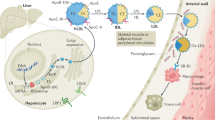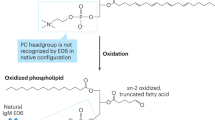Abstract
LIPOPROTEIN(a) (Lp(a)) has been strongly linked with atherosclerosis and is an independent risk factor for myocardial infarction1–6. Distinguishing Lp(a) from other low-density lipoprotein particles is its content of a unique apoprotein, apo(a)7–9. The recently described sequence of apo(a) indicates a remarkable homology with plasminogen10,11, the zymogen of the primary thrombolytic enzyme, plasmin. Lp(a) may contain 37 or more disulphide-looped kringle structures, which are 75–85% identical to the fourth kringle of plasminogen. Plasminogen receptors are widely distributed on blood cells12 and are present at extremely high density on endothelial cells13,14. These receptors promote thrombolysis by accelerating plasminogen activation13,15 and protecting plasmin from inhibition12,16. If, by molecular mimicry, Lp(a) competes with plasminogen for receptors, then thrombolysis would be inhibited and thrombosis promoted. Here we provide support for such a mechanism being responsible for the thrombotic risks associated with elevated Lp(a) by demonstrating that Lp(a) inhibits plasminogen binding to cells.
This is a preview of subscription content, access via your institution
Access options
Subscribe to this journal
Receive 51 print issues and online access
$199.00 per year
only $3.90 per issue
Buy this article
- Purchase on Springer Link
- Instant access to full article PDF
Prices may be subject to local taxes which are calculated during checkout
Similar content being viewed by others
References
Dahlen, G., Berg, K., Gillnas, T. & Ericson, C. J. clin. Genet. 7, 334–341 (1975).
Koltringer, P. & Jurgens, G. Atherosclerosis 58, 187–198 (1985).
Armstrong, V. W. et al. Atherosclerosis 62, 249–257 (1986).
Rhoads, G. G., Dahlen, G., Berg, K., Morton, N. E. & Dannenberg, A. L. J. Am. Med. Ass 256, 2540–2544 (1986).
Hoefler, G. et al. Arteriosclerosis 8, 398–401 (1988).
Dahlen, G. H. et al. Circulation 74, 758 (1986).
Gaubatz, J. W., Heideman, C., Gotto Jr, A. M., Morrisett, J. D. & Dahlen, G. H. J. biol. Chem. 258, 4582–4589 (1983).
Utermann, G. & Weber, W. FEBS Lett. 154, 357–361 (1983).
Fless, G. M., Rolih, C. A. & Scanu, A. M. J. biol. Chem. 259, 11470–11478 (1984).
McLean, J. W. et al. Nature 330, 132–137 (1987).
Eaton, D. L. et al. Proc. natn. Acad. Sci. U.S.A. 84, 3224–3228 (1987).
Miles, L. A. & Plow, E. F. Fibhnolysis 2, 61–71 (1988).
Hajjar, K. A., Harpel, P. C., Jaffe, E. A. & Nachman, R. L. J. biol. Chem. 261, 11656–11662 (1986).
Miles, L. A., Levin, E. G., Plescia, J., Collen, D. & Plow, E. F. Blood 72, 628–635 (1988).
Miles, L. A. & Plow, E. F. J. biol. Chem. 260, 4303–4311 (1985).
Plow, E. F., Freaney, D. E., Plescia, J. & Miles, L. A. J. Cell Biol. 103, 2411–2420 (1986).
Lu, H. et al. Biochem. biophys. Res. Commun. 155, 418–422 (1988).
Silverstein, R. L., Friedlander Jr, R. J., Nicholas, R. L. & Nachman, R. L. J.clin. Invest. 82, 1948–1955 (1988).
Harpel, P. C., Chang, T.-S. & Verderber, E. J. biol. Chem. 260, 4432–4440 (1985).
Miles, L. A., Dahlberg, C. M. & Plow, E. F. J. biol. Chem. 263, 11928–11934 (1988).
Fless, G. M., Snyder, M. L. & Scanu, A. M. J. Lipid Res. (in the press).
Sottrup-Jensen, L., Claeys, H., Zajdel, M., Petersen, T. E. & Magnusson, S. in Progress in Chemical Fibrinolysis and Thrombolysis Vol. 3 (eds Davidson, J. F., Rowan, R. M., Samama, M. M. & Desnoyers, P. C.) 191–209 (Raven, New York, 1978).
Castellino, F. J., Ploplis, V. A., Powell, J. R. & Strickland, D. K. J. biol. Chem. 256, 10864–10869 (1981).
Plow, E. F. & Collen, D. J. biol. Chem. 256, 10864–10869 (1981).
Ploplis, V. A., Cummings, H. S. & Castellino, F. J. Biochemistry 21, 5891–5897 (1982).
Cole, K. R. & Castellino, F. J. Arch. Biochem. Biophys. 229, 568–575 (1984).
Armstrong, V. W., Walli, A. K. & Seidel, D. J. Lipid Res. 26, 1314–1323 (1985).
Author information
Authors and Affiliations
Rights and permissions
About this article
Cite this article
Miles, L., Fless, G., Levin, E. et al. A potential basis for the thrombotic risks associated with lipoprotein(a). Nature 339, 301–303 (1989). https://doi.org/10.1038/339301a0
Received:
Accepted:
Issue Date:
DOI: https://doi.org/10.1038/339301a0
This article is cited by
-
Lipoprotein (a): Does It Play a Role in Pediatric Ischemic Stroke and Thrombosis?
Current Atherosclerosis Reports (2023)
-
Crosstalk between neurological, cardiovascular, and lifestyle disorders: insulin and lipoproteins in the lead role
Pharmacological Reports (2022)
-
Prognostic value of lipoprotein (a) level in patients with coronary artery disease: a meta-analysis
Lipids in Health and Disease (2019)
-
Inhibition of Neointima Formation through DNA Vaccination for Apolipoprotein(a): A New Therapeutic Strategy for Lipoprotein(a)
Scientific Reports (2013)
Comments
By submitting a comment you agree to abide by our Terms and Community Guidelines. If you find something abusive or that does not comply with our terms or guidelines please flag it as inappropriate.



